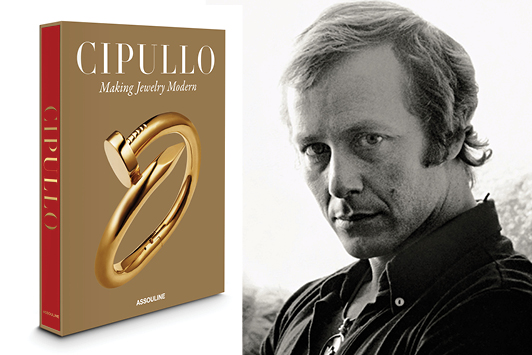
One of the most iconic jewels of the 20th century was designed as a modern symbol of everlasting love, following its creator’s heartbreak. This design staple — a bracelet fastened to the wearer’s wrist with a special screwdriver — could have been signed Tiffany & Co. if the company had accepted Aldo Cipullo’s groundbreaking idea. Instead, Cartier New York snapped up the concept, and the rest is history. The bangle has been seen on celebrities’ wrists since it launched in 1969, and it has since become an indispensable item in the collection of any fashion-conscious woman or man.
The beautifully illustrated and elegantly narrated coffee-table book Cipullo: Making Jewelry Modern shows that the designer’s creative range was much wider than this classic best-seller for which he became famous. Coauthored by Renato Cipullo — the subject’s younger brother, who is also a jeweler — and jewelry historian Vivienne Becker, it is a perceptive and moving homage to one of the design innovators of the past century. The publication mixes jewelry with personal photos, taking the reader back to the vibrant 1960s and 1970s.
Born in Naples, Italy, as the eldest son of a costume-jewelry manufacturer, Aldo grew up in Rome, studied architecture and art, and from an early age dreamed of America. Renato evokes a young man dressed in pioneering blue jeans and a Stetson, who tried his luck in the Italian cinema but didn’t look Latin enough. In 1959, when he was in his early 20s, Aldo immigrated to the US. Two years after arriving in the land of opportunity, he joined David Webb as a bench jeweler, where he spent five years before moving to Tiffany’s design studio.
“What is most remarkable [in] looking at his work for Tiffany is the dramatic transformation that he was clearly able to perform in moving from this sumptuously flamboyant, representational and referential style to his signature abstract and minimalist modernism,” Becker notes.
The writer had access not only to the archives of the jewelry houses where Cipullo worked, but also to many friends’ testimonies and to unparalleled insights from Renato.
At Cartier New York, where Aldo transferred when he offered the jeweler his iconic bangle, he developed more instant successes, including the hardware-inspired Nail collection. His innate sense of mixing creativity and merchandising (a trait he shared with his friend Andy Warhol) perfectly suited the American company’s strategy.
He left the jeweler in 1974 to dedicate himself to his own brand, creating more designs that resonated with a contemporary audience looking for playful, fashion-forward jewelry. The American Gem Society (AGS) recognized his masterful use of gemstones when it commissioned a series with stones mined in America.
Cipullo died in 1984. His gemstone collection is on display at the Smithsonian Institution, an achievement for the Italian-born jeweler who had a boundless love for his adopted country. As for his legendary creations, they are still turning heads among the new generation of jewelry lovers.
Cipullo: Making Jewelry Modern is published by Assouline.
Article from the Rapaport Magazine - April 2021. To subscribe click here.